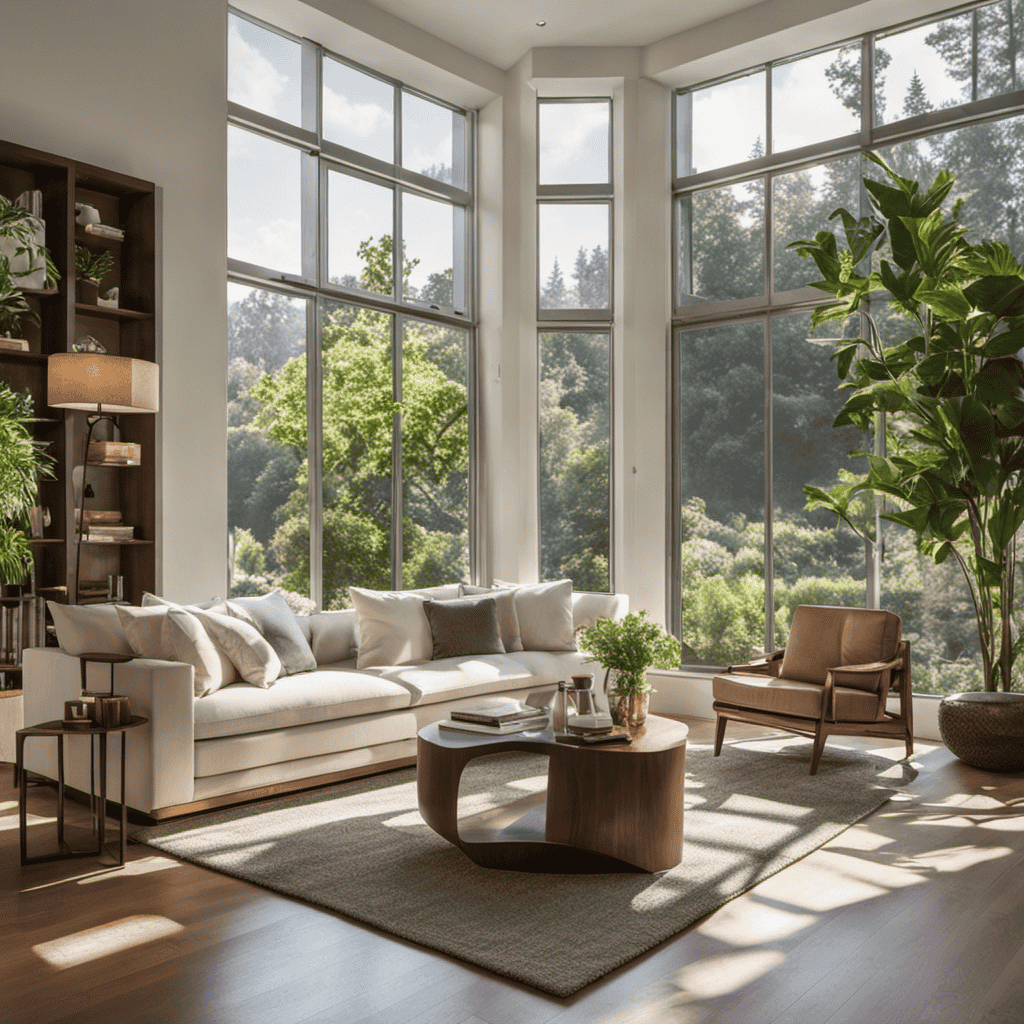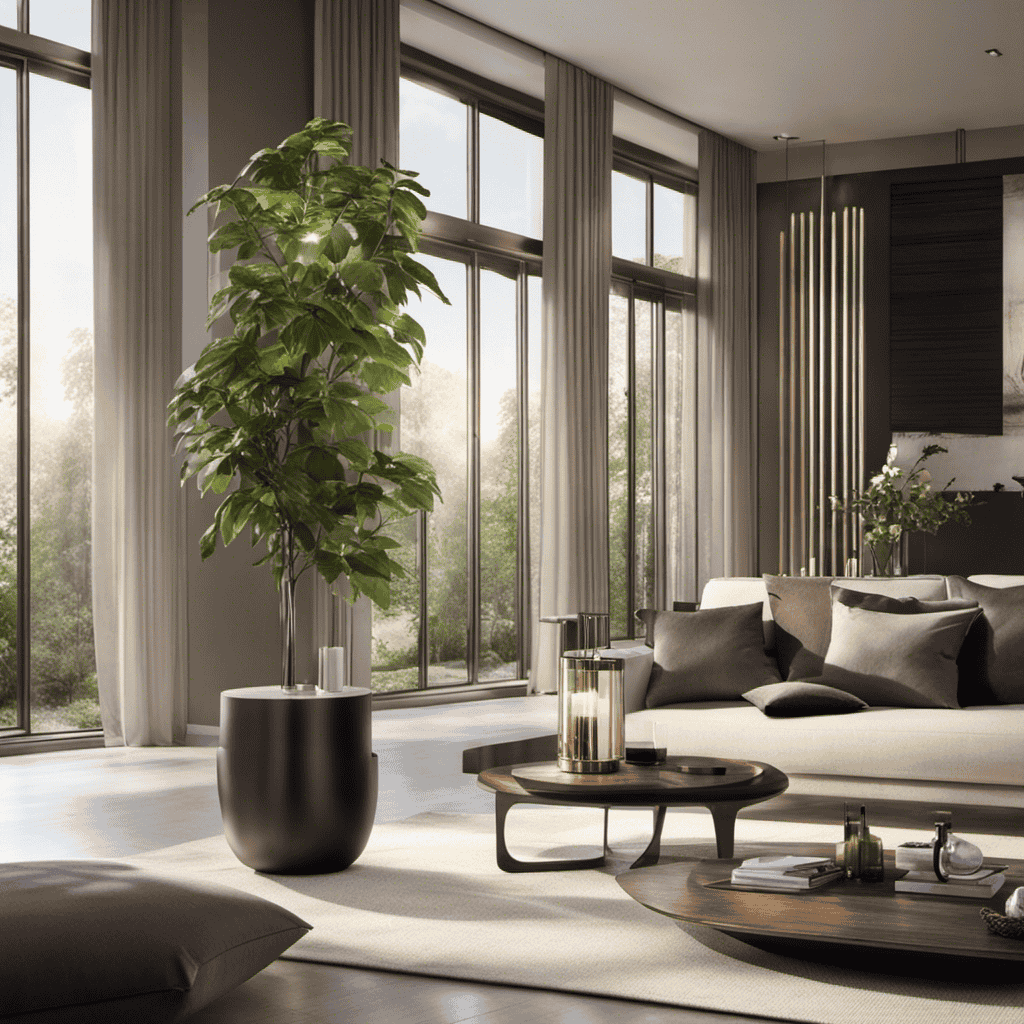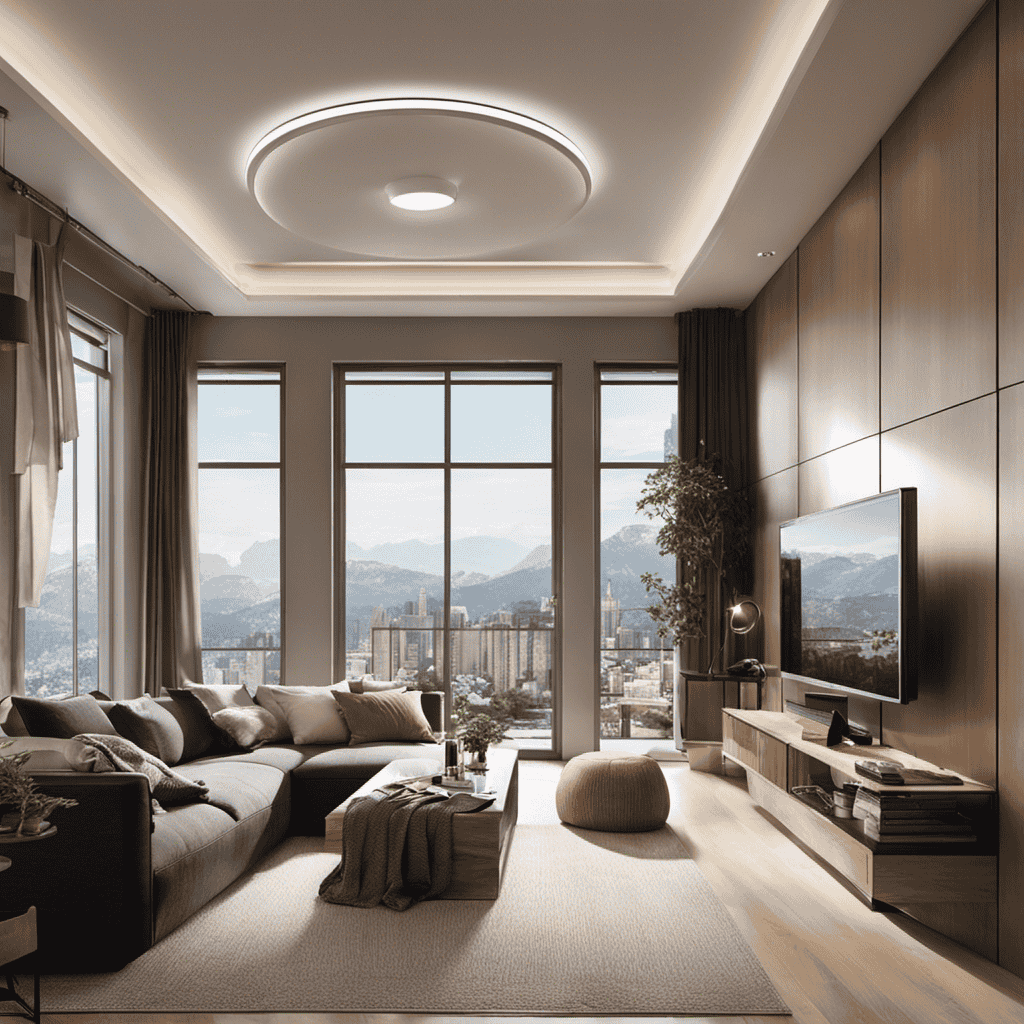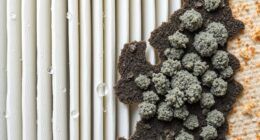I have always been curious about the frequency at which I should run my air purifier to ensure that my indoor air remains clean and fresh. Were you aware that the average person spends approximately 90% of their time indoors? That equates to a significant amount of time breathing air that could potentially be contaminated.
In this article, I’ll provide you with all the information you need to determine the optimal operation schedule for your air purifier. From daily usage to adjusting run times for different room sizes, we’ll cover it all.
Let’s dive in and breathe easier.
Key Takeaways
- Running the air purifier daily, during both daytime and nighttime, is recommended for optimal air quality.
- Regularly cleaning or replacing filters is necessary to maintain the efficiency of the air purifier.
- Adjusting the run times of the air purifier based on specific needs and monitoring air quality levels is important for an optimal schedule.
- Customizing run times based on room size helps maximize the performance of the air purifier.
Daily Operation
You should run the air purifier daily to achieve optimal air quality. Running it during the daytime is essential, but nighttime operation is equally important. While you sleep, the air in your bedroom can become contaminated with allergens, dust, and other pollutants. By running the air purifier at night, you can ensure that you wake up to clean and fresh air.
In addition to daily operation, proper maintenance of your air purifier is crucial. Regular maintenance helps to prolong the life of your purifier and maintain its efficiency. It is recommended to clean or replace the filters as per the manufacturer’s instructions. Filters can get clogged with pollutants over time, reducing the effectiveness of the purifier. By keeping them clean, you allow the purifier to work at its optimal level, ensuring that it continues to remove contaminants from the air.
Moreover, it is important to regularly check the condition of the purifier. Look for any signs of damage or wear and tear, such as loose parts or malfunctioning buttons. If you notice any issues, it is advisable to contact the manufacturer or a professional technician for assistance.
Nighttime Usage
When it’s bedtime, it’s best to keep the air purifier running throughout the night for optimal air quality. Many people may wonder if the noise level of the air purifier will affect their sleep quality. The good news is that most modern air purifiers are designed to operate quietly, ensuring a peaceful environment for sleep.
However, if you are sensitive to noise or easily disturbed during sleep, you may want to consider adjusting the noise levels of your air purifier. Some models offer different fan speed settings, allowing you to choose a quieter mode specifically designed for nighttime use.
The impact of an air purifier on sleep quality goes beyond just noise levels. Air purifiers help to remove airborne particles such as dust, pollen, and pet dander, improving the overall air quality in your bedroom. Breathing in clean air during sleep can lead to better rest and improved respiratory health.
Additionally, air purifiers can help reduce odors and eliminate harmful pollutants, creating a fresh and healthy sleeping environment.
In conclusion, running an air purifier throughout the night can have a positive impact on sleep quality by ensuring clean and fresh air. By adjusting noise levels and choosing a quieter mode, you can enjoy the benefits of an air purifier without any disturbance to your sleep.
Running During Allergen Seasons
During allergy seasons, it’s important to keep the air purifier running to filter out allergens and improve air quality. As someone who has experienced the discomfort of seasonal allergies, I understand the importance of finding relief. Here are a few key reasons why running an air purifier during allergy seasons can be beneficial:
-
Reducing Allergens: An air purifier works by capturing and filtering out allergens such as pollen, dust mites, and pet dander. By continuously running the purifier, you can significantly reduce the allergen levels in your indoor air.
-
Improving Sleep: Nighttime can be particularly challenging for individuals with seasonal allergies. By running the air purifier in your bedroom, you can create a clean and allergen-free sleeping environment, which may help you breathe easier and get a better night’s sleep.
-
Preventing Allergy Flare-ups: By maintaining a consistent operation of your air purifier, you can continuously remove allergens from your home, preventing them from accumulating and triggering allergy symptoms.
Continuous Running Vs. Scheduled Intervals
When it comes to running, there are different approaches that can be taken: continuous running or scheduled intervals. Both have their pros and benefits to consider.
Continuous running allows for a steady pace and endurance building, while scheduled intervals provide opportunities for speed and recovery.
It’s important to also consider energy consumption when deciding on the best approach for your running routine.
Pros of Continuous Running
The pros of continuous running include improved air quality and reduced allergens. Running your air purifier continuously throughout the day and night can have several benefits, especially during nighttime hours. Here are a few reasons why continuous running is beneficial:
-
Nighttime Benefits: Running the air purifier all night ensures that you can breathe clean and fresh air while you sleep. This can help improve your sleep quality and overall well-being.
-
Energy Efficiency: Contrary to popular belief, running an air purifier continuously can actually be energy-efficient. Many modern air purifiers are designed to be energy-efficient and consume minimal power, even when running continuously.
-
Consistent Air Quality: Continuous running ensures that the air purifier is constantly working to remove pollutants, allergens, and other airborne particles from the air. This helps maintain a consistent level of air quality throughout the day, reducing the risk of allergies and respiratory issues.
Benefits of Scheduled Intervals
Running your air purifier on a schedule can help maintain consistent air quality and reduce allergens. By adjusting run times based on your specific needs, you can maximize the health benefits it provides.
Regularly cleaning the filters and monitoring air quality levels can help determine the optimal schedule for your air purifier. For example, if you have allergies or respiratory issues, you may want to run the purifier more frequently, especially during peak allergy seasons. On the other hand, if you live in an area with clean air, running it less frequently may be sufficient.
Energy Consumption Considerations
When considering how often to run your air purifier, it’s essential to take energy consumption into consideration. Running your purifier all the time can lead to increased energy usage and higher electricity bills. To help you save energy while maintaining clean air, here are some energy-saving tips and purifier maintenance practices:
- Set your purifier on a timer to run only when you’re at home or during peak pollution hours.
- Clean or replace the filters regularly to ensure optimal airflow and efficiency.
- Consider using a smart purifier that adjusts its speed based on the air quality in the room.
By following these energy-saving tips and maintaining your purifier properly, you can enjoy cleaner air while minimizing energy consumption.
Now, let’s explore the implications of running an air purifier in high pollutant areas.
Running in High Pollutant Areas
When it comes to running an air purifier in high pollutant areas, it is important to understand the optimal usage, pollutant levels, and frequency of operation.
Optimal Purifier Usage
To get the most out of your air purifier, it’s important to use it consistently and not just occasionally. Here are some tips for optimal usage:
-
Nighttime usage: Running your air purifier during the night can help improve your sleep quality by filtering out allergens and pollutants that may cause discomfort or respiratory issues.
-
Energy consumption considerations: While it’s important to use your air purifier consistently, you should also be mindful of its energy consumption. Consider using energy-saving features or setting a timer to run it for a specific duration. This way, you can enjoy clean air without worrying about excessive energy usage or skyrocketing utility bills.
-
Placement: Ensure that your air purifier is placed in the right area to maximize its effectiveness. Position it in a central location to allow for better air circulation throughout the room.
Pollutant Levels and Frequency
Now that we understand the optimal usage of air purifiers, let’s delve into the importance of pollutant control and how it can improve air quality.
Air purifiers play a vital role in removing various pollutants from the air, such as dust, pollen, pet dander, and even harmful chemicals. By continuously running the air purifier, you can ensure that these pollutants are consistently being filtered out, leading to cleaner and healthier air.
However, the frequency of running the air purifier depends on the pollutant levels in your environment. If you live in an area with high levels of pollution or if you have allergies or respiratory issues, it is recommended to run the purifier more frequently.
Transitioning to the next section, let’s now explore the health benefits that filtration provides.
Health Benefits of Filtration
Using an air purifier can greatly improve your health by filtering out harmful pollutants. Not only does it help to remove allergens and irritants from the air, but it also plays a crucial role in maintaining good indoor air quality. Here are three key health benefits of using an air purifier:
-
Reduces respiratory problems: Air purifiers can effectively remove airborne particles such as dust, pollen, and pet dander, which can trigger allergies and asthma. By eliminating these pollutants, air purifiers can help reduce the risk of respiratory problems and improve overall lung function.
-
Eliminates odors and chemicals: Air purifiers equipped with activated carbon filters can eliminate unpleasant odors and harmful chemicals from the air. This is particularly beneficial for individuals with sensitivities or allergies to certain chemicals, as it helps create a healthier and more comfortable living environment.
-
Prevents airborne diseases: Air purifiers can help reduce the spread of airborne diseases by capturing and neutralizing bacteria, viruses, and other microorganisms. This is especially important during flu seasons or when someone in the household is sick, as it can help minimize the risk of infection and promote a healthier living space.
Determining Optimal Run Times
Figuring out the best times to run your air purifier can greatly improve its effectiveness. Adjusting run times based on your specific needs and circumstances is key to optimizing its performance. Additionally, proper maintenance is essential to ensure that your purifier continues to function efficiently.
When determining the optimal run times for your air purifier, consider the level of air pollution in your area. If you live in a highly polluted environment or have allergies, it may be beneficial to run your purifier constantly, especially during peak pollution hours. On the other hand, if you live in a relatively clean area, running the purifier for a few hours a day might be sufficient.
In terms of maintenance, regular filter changes are crucial. Depending on the purifier model, filters should be replaced every three to six months. Check the manufacturer’s instructions for specific guidance. Additionally, keeping the purifier clean by regularly wiping down the exterior and ensuring proper airflow can help maintain its efficiency.
Adjusting Run Times for Room Size
Adjusting run times based on the size of the room is crucial for optimizing the performance of your air purifier. By customizing the run times, you can effectively target and eliminate different pollutants in the air.
Here are three important points to consider when adjusting run times for room size:
-
Pollutant Types: Different pollutants require different run times for effective removal. For example, airborne particles like dust and pollen may require longer run times, while odors and volatile organic compounds (VOCs) may need shorter bursts of purification. Understanding the types of pollutants in your room will help you determine the appropriate run times.
-
Air Flow Optimization: Large rooms often have more air to circulate, requiring longer run times to ensure thorough purification. Adjusting the run times can help optimize the air flow and ensure that all corners of the room are effectively treated. This is especially important in rooms with poor ventilation or areas that are prone to high pollutant levels.
-
Energy Efficiency: Adjusting run times not only helps optimize air purification but also promotes energy efficiency. By setting appropriate run times based on the room size, you can reduce energy consumption and save on electricity costs.
In conclusion, adjusting run times based on room size is essential for achieving optimal air purification. By considering the types of pollutants, optimizing air flow, and promoting energy efficiency, you can maximize the performance of your air purifier.
Now, let’s delve into the next section, which focuses on running the air purifier during illness or allergy flare-ups.
Running During Illness or Allergy Flare-ups
During illness or allergy flare-ups, it’s important to run the air purifier to help alleviate symptoms and improve indoor air quality. I personally find that running the air purifier during colds and the pollen season provides significant relief.
When you’re sick with a cold, your body is already working hard to fight off the virus. It’s crucial to create a clean and healthy environment to support your recovery. Running the air purifier can help remove airborne particles like bacteria and viruses, reducing the risk of cross-contamination within your home.
Similarly, during pollen season, allergies can wreak havoc on our respiratory systems. The air purifier becomes an indispensable tool in reducing the amount of pollen circulating indoors. By capturing and trapping pollen particles, it helps to minimize allergy symptoms such as sneezing, itching, and congestion.
To emphasize the benefits of running the air purifier during illness or allergy flare-ups, let’s take a look at the following table:
| Air Purifier Benefits |
|---|
| Alleviates symptoms |
| Improves air quality |
| Reduces cross-contamination |
| Minimizes allergy symptoms |
Running in Smoky Environments
When it comes to running the air purifier in smoky environments, it’s important to be aware of the potential health effects that smoky air can have.
Inhaling smoky air can irritate the respiratory system and worsen existing conditions such as asthma or allergies.
To minimize the health risks, it’s recommended to run the air purifier continuously in smoky environments to ensure that it effectively filters out the harmful particles and improves the air quality.
Smoky Air’s Health Effects
If you live in an area with smoky air, using an air purifier can help reduce the health effects. Smoke from wildfires and other sources can contain harmful particles and pollutants that can irritate the respiratory system and worsen existing health conditions.
Breathing in smoky air can lead to short-term effects such as coughing, wheezing, and difficulty breathing, as well as long-term effects like respiratory infections and cardiovascular problems.
To assess the air quality in your area and determine the need for an air purifier, you can consult an air quality assessment service or use a portable air quality monitor. These devices measure the levels of particulate matter and pollutants in the air, providing you with valuable information to make informed decisions about using an air purifier.
Optimal Purifier Run-Time
To maximize the effectiveness of your air purifier, it’s important to regularly check and replace the filters. This ensures that your purifier is able to efficiently remove pollutants and allergens from the air. But another important factor in optimizing your air purifier’s performance is determining the optimal run-time. While running your purifier throughout the day is beneficial, there are also nighttime benefits to consider. During the night, when the air is usually cooler and there is less activity, the purifier can work more effectively without the interference of open windows or doors. This allows it to thoroughly clean the air in your bedroom, providing you with cleaner and fresher air to breathe while you sleep. By running your air purifier at night, you can enhance its overall effectiveness and enjoy the improved air quality it provides.
To help you understand the benefits of running your air purifier during the night, here is a table showcasing the nighttime benefits and its impact on purifier effectiveness:
| Nighttime Benefits | Purifier Effectiveness |
|---|---|
| Cooler air | More efficient |
| Less activity | Uninterrupted cleaning |
| Reduced allergens | Enhanced air quality |
Running During Home Renovations
Running the air purifier during home renovations can help remove dust and other particles from the air. This is especially beneficial when running the air purifier during painting or construction projects, as these activities tend to generate a significant amount of dust and debris. By running the air purifier, you can improve the air quality in your home and create a healthier living environment.
Here are three reasons why running the air purifier during home renovations is a good idea:
-
Dust removal: Renovations often stir up dust particles that can linger in the air for an extended period. Running the air purifier helps capture and remove these particles, preventing them from settling on surfaces or being inhaled.
-
Allergen reduction: Renovations can also trigger allergies and asthma symptoms due to the release of allergens like pollen, mold spores, and pet dander. An air purifier with a HEPA filter can effectively trap and eliminate these allergens, providing relief to those with sensitivities.
-
Odor control: Home renovations can sometimes introduce unpleasant odors from paint, adhesives, or building materials. By running the air purifier, you can help eliminate these odors and maintain a fresh-smelling indoor environment.
Is There a Recommended Frequency for Running an Air Purifier?
The recommended air purifier running frequency depends on factors like air quality, size of the room, and specific health concerns. Generally, running the air purifier 24/7 ensures consistent clean air. However, adjusting the running frequency based on individual needs and environmental conditions can optimize its effectiveness.
Frequently Asked Questions
Can I Run the Air Purifier All Day and Night?
Yes, you can run the air purifier all day and night. However, it’s important to consider proper air purifier maintenance to ensure its optimal performance.
Running the air purifier continuously can provide numerous benefits, such as removing allergens, pollutants, and odors from the air. Regularly cleaning or replacing the filters is essential to maintain its efficiency.
Additionally, monitoring the air quality and adjusting the settings accordingly can help create a clean and healthy indoor environment.
How Often Should I Clean or Replace the Air Purifier Filters?
When it comes to air purifier filters, it’s important to know how often they should be replaced and how to clean them properly.
The frequency of filter replacement depends on factors like the manufacturer’s recommendations, the air quality in your area, and how often you use the purifier.
As for cleaning, it’s generally recommended to clean the filters every 1-3 months.
Regular maintenance ensures that your air purifier continues to work efficiently and effectively to clean the air in your home.
Does Running the Air Purifier Increase My Electricity Bill Significantly?
Running the air purifier does increase my electricity bill, but not significantly. To make it cost effective, I follow energy saving tips for air purifiers.
I set the purifier on a lower fan speed or use the timer function to run it for a few hours a day. I also keep the doors and windows closed to prevent outdoor pollutants from entering.
These small adjustments help me maintain clean air while minimizing energy consumption.
Can I Use an Air Purifier in Multiple Rooms at the Same Time?
Using an air purifier in multiple rooms simultaneously can be beneficial for maintaining clean and fresh air throughout your home.
However, it’s essential to consider the size of each room and choose the appropriate air purifier accordingly.
Placing the purifiers strategically in central areas of each room will ensure maximum air circulation and purification.
Remember to adjust the settings and fan speed based on the specific needs of each room.
What Is the Recommended Distance Between the Air Purifier and Other Objects or Walls for Optimal Performance?
I recommend placing your air purifier at a distance of at least 3 feet from other objects or walls for optimal performance.
This allows for proper air circulation and ensures that the purifier can effectively capture and filter pollutants.
Conclusion
In conclusion, it is important to understand the optimal frequency for running an air purifier in order to ensure clean and healthy air in your home.
By considering factors such as daily operation, nighttime usage, allergen seasons, and pollutant levels, you can customize your air purifier’s run times to effectively address your specific needs.
Whether it’s adjusting run times for room size or running during illness or allergy flare-ups, finding the right balance is crucial.
Remember, just as the saying goes, ‘Clean air is like a breath of fresh life.’ So, take control of your indoor air quality and breathe easy.










